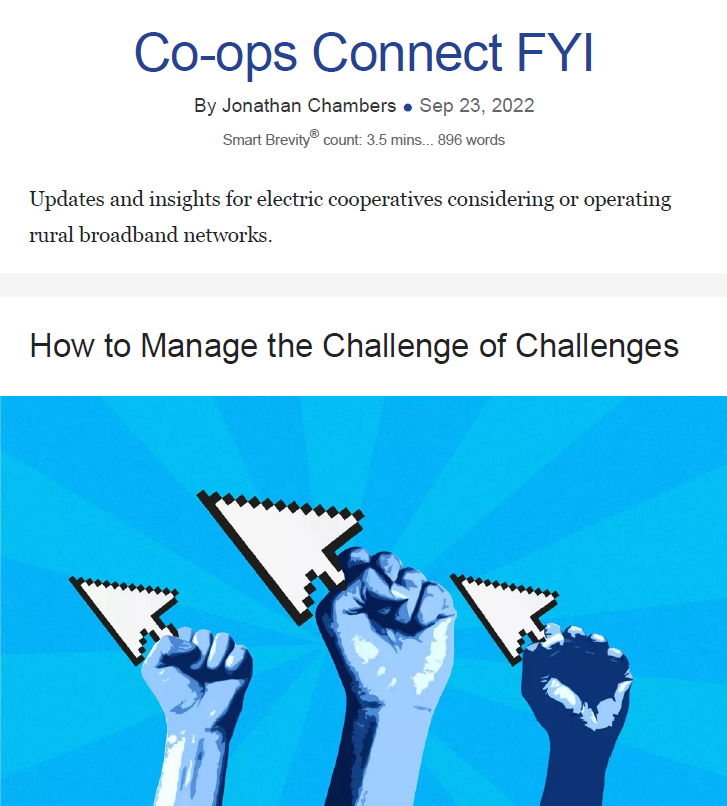How to Manage the Challenge of Challenges
September 23, 2022
Superficially, the argument has been compelling. Scarce public resources shouldn’t be wasted on broadband for areas that are already served by broadband.
It’s from an old incumbent playbook:
- Define broadband at such a low level (4/1 Mbps, then 10/1 Mbps, then 25/3 Mbps) that nearly every location is considered served.
- Assert that there shouldn’t be competition in rural areas because rural areas can’t sustain multiple providers.
- Fall back to the position that if there is competition, there should only be one recipient of subsidies and that should be the incumbent.
- Fall further back to the position that if the subsidies are open to competition, the incumbent should receive a right of first refusal.
- Argue that if new entrants receive subsidies, there should be no “overbuilding,” which is defined by incumbents as competition.
- Argue further that new entrants should not receive subsidies where the incumbent claims it has future plans to provide broadband.
- Argue still further that if there are applications for funding unserved areas, those application areas should be made public and subject to challenge.
- Dispute all new entrant applications by merely asserting service availability.
- Keep the details of the challenge hidden from the public.
- Refuse to provide any objective evidence by asserting the evidence is proprietary.
- And so on and so on.
Why it matters:
Several states, such as Mississippi, New York, and Georgia, identify locations and geographic areas eligible for funding prior to, or as part of, the notice of funding opportunity.
- In other words: The state mapping process resolves the challenges prior to the application process.
Other states, such as Louisiana, Kentucky, and Florida, allow incumbents to challenge applications for funding even where the applicants rely on the state broadband maps.
- The challenge process is, of course, a ruse. Incumbents have been caught repeatedly misrepresenting their service areas and service levels.
The bottom line:
You’ll have to learn to play the game if you live in a state where the legislature or broadband office has been hoodwinked by incumbents.
How to Control the Game: Advice for State Broadband Offices
Three simple steps to manage the challenge process:
1. The Infrastructure Act provides States with statutory guidance. Projects eligible for funding are those that are unserved or underserved with the following definitions:
- The term ‘‘unserved service project’’ means a project in which not less than 80 percent of broadband-serviceable locations served by the project are unserved locations.
- The term ‘‘underserved service project’’ means a project in which not less than 80 percent of broadband-serviceable locations served by the project are unserved locations or underserved locations.
- Unserved is defined as lacking 25/3 Mbps; underserved as lacking 100/20 Mbps.
Why it matters:
- Simple, right? Let’s say a state has prioritized unserved locations. Let’s say an application proposes to make service available to 1,000 unserved locations and uses the state or federal broadband map to identify unserved locations.
- In this example, a challenger should have to demonstrate more than 200 served locations to dispute the application. Otherwise, the Infrastructure Act deems such an application an appropriate unserved service project.
2. What then would constitute evidence of service in a challenge? Most challenges are mere assertions of service availability.
- Some include the challenger’s FCC 477 data, which is the advertisement of service availability within a census block.
- If an applicant has relied on state or federal broadband data regarding unserved or underserved locations, there should be a presumption that the locations are unserved/underserved.
- Overcoming that presumption should require more than mere assertions.
Why it matters:
Speed tests are the coin of the realm.
- In the case of an incumbent challenge, speed tests should follow an official testing protocol.
- The FCC published speed test protocols for every ISP that receives federal funding for rural areas.
- Those are the same protocols that should be used by challengers.
- It is a simple matter for state broadband offices to verify the validity of speed tests that follow the FCC’s protocols.
3. A state broadband office should provide the applicant with an opportunity to remove served locations from the application sufficient in number to meet the 80% threshold.
- Why it matters: That should be the end of the challenge.
The bottom line:
The challenge process doesn’t have to be lengthy and overcomplicated. The entire process shouldn’t require more than a few weeks.
The Big Picture
If NTIA wants to be useful, it could set out clear guidelines and technical assistance for a state challenge process.
I understand the attraction to policymakers of a challenge process. But I’ve seen it abused at the state and federal level.
And to what end? Mostly to satisfy a phony argument about overbuilding.
- As a practical matter, the “overbuilding” argument has led to a pernicious, damaging set of policies and delayed the effort to improve the lives and livelihoods of rural Americans.
- The “overbuilding” argument has been the rationale for the absurd new location-specific broadband maps, and the rationale for challenge processes at the state and federal levels.
- The “overbuilding” argument has delayed broadband in rural America for the better part of a decade. And it will continue to cause delay.
